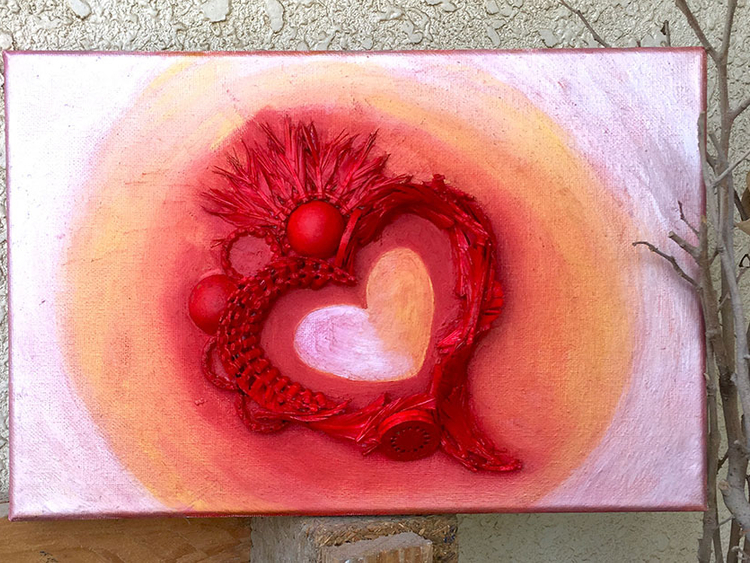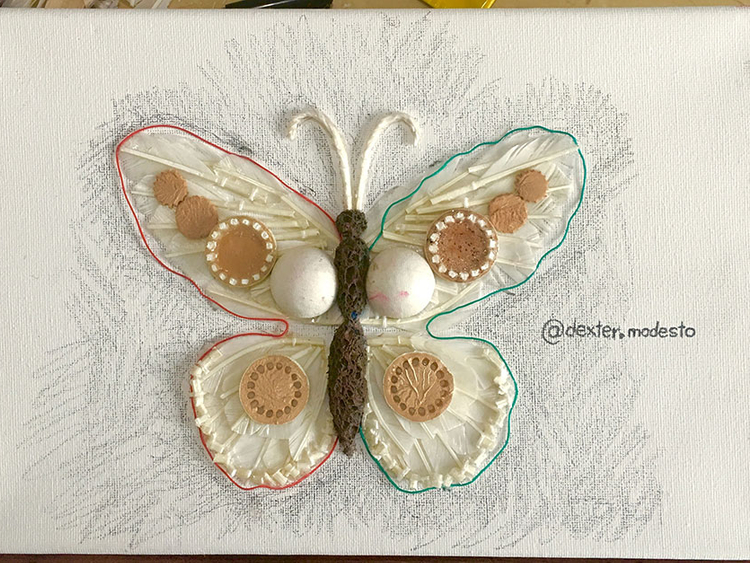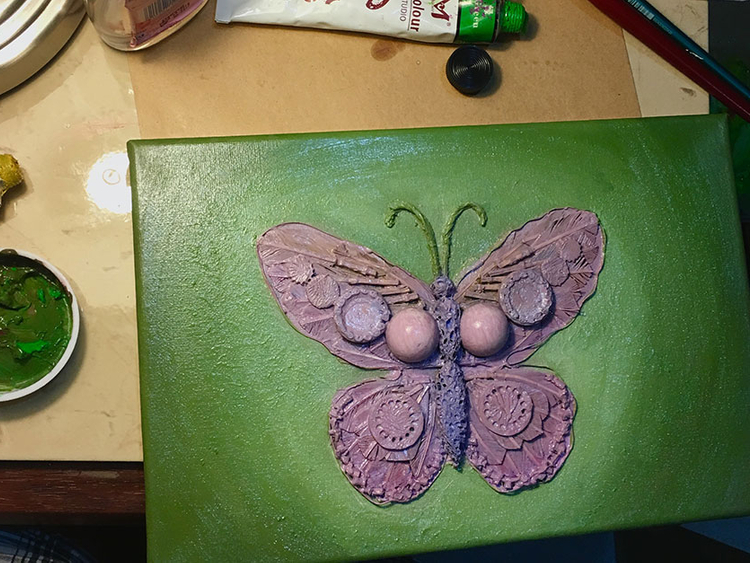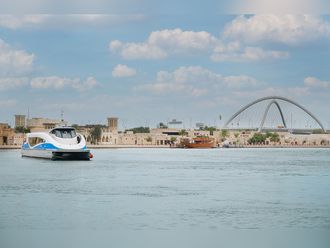Dubai: Dexter Modesto, a 37-year-old Filipino architect in Dubai, is perhaps one of those who have managed to stay ahead of their battles with depression in a truly unique way: he creates pieces of art out of discarded shuttlecocks.
“It was actually an accident that I was able to find these shuttlecocks,” Modesto tells Gulf News #Pinoy. “It all began when depression got to me; I was financially and emotionally drained.”
Depression is a serious mental disorder that, perhaps many are not aware of, is quite common. According to the World Health Organisation, more than 300 million people of all ages suffer from depression globally. Different people deal with the problem in their own distinct ways.
For Modesto, playing badminton was his way of overcoming depression. “June 2016, that was when I started playing badminton and also that was the time that I was struggling about my life,” he shares. “It came to a point where my self-confidence and self-esteem were so low, I almost compared myself to garbage, like literally I felt like a useless person. I was hearing the voice of my previous bosses and managers in my mind, saying that my works are rubbish. This has kept me from believing that I can never go far. But there’s one thing I know for sure: I have an eye for detail.”

Modesto says his curiosity got him thinking about the shuttlecock’s “life”. After they are used a number of times, the shuttlecocks are discarded and in that sense, Modesto says he shared the same feeling: “We are rubbish in some way.”
But that also marked a turning point in his life. “It feels weird to think about that, but I think the shuttlecocks also need to be recognised,” he says. “I felt like they have chosen me to represent them. It’s kind of weird to think about these things, but I’m so happy.”
Modesto says he just suddenly felt an urge to do something about the shuttlecocks and not let them go to waste. And perhaps unconsciously, those thoughts helped restore an inner confidence about his abilities to achieve something.
With his background in the arts, Modesto started creating art installations with used shuttlecocks. Eventually, there was not enough, so he roamed around the different clubs, with some players who appreciated his creations also helping collect used pieces of badminton shuttles.
In one artwork, Modesto uses up to a hundred used shuttlecocks. He says it can be a challenge sourcing the unique materials that he uses, but it has been a healing process for him, allowing him to make the necessary adjustments to fix the problems in his life.

“This has been a way of expressing my emotions, it’s a way to escape stress, it’s a way to escape from one world to another. I feel like I have escaped the world in a few hours, in a few minutes or in days – days of endless artworks, endless painting,” he says. “I feel like I’m a very accomplished person, as an artist, because I was able to give justice to these shuttlecocks. I’ve realised that I inspire people now, people who have lost their ability to see their worth or still don’t know their purpose in life.”
And because of his methods, his artworks eventually led to another advocacy: recycling. “No one has ever thought that these shuttlecocks can be turned into these magnificent artworks,” he says.
Modesto reveals more in this Q&A with #Pinoy:
How many artworks have you made using shuttlecock? Are you selling them?
I have made approximately 40 artworks and counting, with sizes varying from A4 to A1. I usually create these artworks in A4 sizes and bring them every weekend during our badminton games for raffle. My purpose is to inspire more players to come and play and to promote my artwork with my advocacy on recycling. I never thought of selling it, but many people were asking about prices every time I post them on Facebook or Instagram. So I grabbed the opportunity; it also helps cover my expenses in buying other materials like canvas, paints and brushes.

What are the challenges of creating artworks made of shuttlecock?
The challenging part is preparing and cutting them. You have to separate the feathers, and what I call the skeleton. I have to separate each. I usually work on my art after work. Usually I’ll start at 7pm and finish an average artwork in two weeks working every night, depending on the artwork. Even on my weekends I work on it. So instead of enjoying my life (laughs), going to places with my friends, I would rather keep myself inside my room and work on my artworks.
Which is the most special or memorable?
I’m always proud of all the artworks that I have made. They are all unique in the way they were created. I have spent time with them individually, may it be small or big artwork. So I would say that they are all special and memorable to me. The one I created and gave to Miss Universe 2015 Pia Alonzo Wurtzbach is also memorable for me.

Have you held an exhibit in Dubai or in the UAE with your artwork?
I had a few exhibitions in the UAE. My first display was February of 2017 in Art Hub Dubai Design District (D3). Next exhibit was in Art Hub Abu Dhabi with other contemporary artists in March 2017. I took a rest for a while due to work then I started making artworks again and got back on another exhibit organised by the Islamic Affair & Charitable Activities (IACAD) last March and my latest exhibit was last April in Al Nakheel Hotel in Abu Dhabi.
How was the reception? What comments do you usually get from your audience?
Most of the people don’t expect that these shuttlecocks can be turned into a beautiful masterpiece.
You’re an architect by profession. How did that help you with your art?
It’s really an advantage for me because I can visualise, I can plan. I can sketch. So it’s really a big advantage on my part. Knowledge in cutting and pasting is necessary in doing this type of art, along with lots of patience.
Aside from shuttlecock, what other medium are you using in your artwork?
I’m into mixed media – contemporary art for the reason that it allows me to experiment and utilise all types of paints, acrylic or oil in canvas, wood or paper with different texture with the shuttlecock. The roughness and smoothness or depth regardless of the complexity of my design is the main feature; everybody gets old anyway so I hope when I reach 60 or 70, my eyesight might not be good anymore by that time but I know that I can still feel them by touching every edge. As an architect I like to incorporate shapes, contours or geometric lines so that the final outcome of my artwork will have structural integrity. I love cool, natural earth colours, mixed with bronze, silver or gold.
What is your advice to artistic people who are afraid to showcase their talents?
Art has always been my constant therapy whenever stress comes, and I’m always grateful to God for this talent. I hope to inspire more people and never get tired of promoting my advocacy on recycling. Find some good reason to do what you love doing, keep the fire within your heart, never lose your passion, start doing it now and put a deadline. Never be afraid and it’s never too late, there is always time. Better opportunities await us, but only for those who have the passion, patience and purpose.
With inputs from Jobannie Tabada, Features Editor – Property Weekly
















